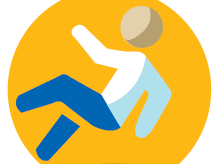History repeats: The high stakes of the digital divide for seniors and why it matters.
2024 What's Next Longevity Venture Summit (online)
2024 Longevity Venture Summit (DC)
 Has anyone you know fallen and couldn’t get up? If so, would you pick up the phone and call Life Alert, the purveyor of those miserable ads on TV? This is not a fun company – read the reviews about working there. Philips launched its own Personal Emergency Response System (PERS) offering in 2005 through the acquisition of Lifeline Systems and gave up 16 years later, selling it to Connect America. Since then, Medical Guardian became a market leader ($100 million investment from WaterStreet), with Florence Henderson as spokesperson. And so some believe this is a viable (standalone?) market and believe that it has a low penetration rate into the potential market of worried older adults or their physicians and families.
Has anyone you know fallen and couldn’t get up? If so, would you pick up the phone and call Life Alert, the purveyor of those miserable ads on TV? This is not a fun company – read the reviews about working there. Philips launched its own Personal Emergency Response System (PERS) offering in 2005 through the acquisition of Lifeline Systems and gave up 16 years later, selling it to Connect America. Since then, Medical Guardian became a market leader ($100 million investment from WaterStreet), with Florence Henderson as spokesperson. And so some believe this is a viable (standalone?) market and believe that it has a low penetration rate into the potential market of worried older adults or their physicians and families.
The Apple Watch was a catalyst for changes in 2018 -- and much change happened. Adding fall detection to the Series 4 Apple Watch in 2018 created a marketing opportunity for watch-based fall detection, see UnaliWear and most of the manufacturers that offer one today. The Apple Watch offered the feature of looking cool AND having fall detection and other features. And there are apps for the watch that will contact a 24x7 call center, like Best Buy and FallCall Solutions. But is the right offering a watch? A band without a watch face? A pendant? Room-based monitoring? Yelling "Help" to a Smart Speaker? Having a panic button connected to Alexa?
Falls (and fear of) are the basis for the PERS industry’s existence. Life Alert’s commercials have long set the gloomy tone for the industry. And the industry conveners like MAMA totally appreciate this product's recurring revenue. Monitoring centers like AvantGuard and LifeStation are beneficiaries of this continued problem, as quantified by the CDC. Combine that data with other stats, like the fact that 44% of women aged 75+ live alone. And one of those, apparently, is 81-year-old Martha Stewart on her farm, who has endorsed a new PERS device from SilverTree, a Boston-based startup company that (with Martha Stewart) may make anonymous industry insiders a bit nervous. One reached out to PERS Insider with this snip: "Devices like these are likely to provide a poor user experience, and it represents a threat to the industry because of the high-profile endorsement and flashy marketing."
So many threats, so little time to innovate. You have to love that sour feedback from a company threatened by the skilled marketing of a competitor. In the past few years the original PERS device concept (a pendant) has been challenged by the Apple Watch and a range of jewelry like Trelawear as well as SilverTree. Meanwhile, edge-based camera tech like KamiCare, video fall capture from SafelyYou, Wi-Fi sensing fall detection from Origin.ai, AI-enabled monitoring from Inspiren – competitors are coming from every direction. Few have worked out the smooth transition from room-based inside-to-outside movement, which could only happen with wearable-related partnerships. And fewer have identified the someday subscription opportunity for a range of services that will matter to the same client/constituent. So many options to consider, so little time. See future -- by 2030 all baby boomers will be 65+.
[See latest report, The Future of AI and Older Adults 2023]
Comments
From Amy Stapleton via LinkedIn
You have to admit, the Silvertree promo video with Martha Stewart is pretty awesome! Definitely made me laugh. I like how they’re approaching the subject with some fun.
From Thomas Glaser via LinkedIn
Thank you Laurie...but you're missing the newest class of wearable enabled services in your insightful and critically valuable research...the Wellbeing Companion...includes all PERS features, Wellness metrics, and Caregiver Care Management tools...all in real time...built for both the User and Caregiver...the logical next generation...
From Adam Russek-Sobol via LinkedIn
This is a great article, but missing the identification of major barrier that has contributed to the lack of innovation….wireless communication…
Some companies rely on their own bases stations with their pendant, others like the Apple Watch rely on a smartphone, and others rely on expensive cellular to get the alert to the internet.
Connectivity has been the biggest issue in this space. Secondary issues have been monthly cost and battery life.
Luckily, there is a new connectivity player in town leveraging hashtag#lpwan hashtag#lora - although the industry is slow to change, this technology and national network coverage for pennies on the dollar is distruptive to the PERS market.
From Craig Hillman via LinkedIn
What's a little sad is that most investment dollars prefer a software-only solution, regardless of efficacy, and fall prediction and detection are preferred over fall prevention because they 'feed the funnel' for healthcare systems and conventional fall prevention has gotten such a bad wrap because it is seen as widely ineffective.
From Adam Russek-Sobol via LinkedIn
This is more than a little sad. In reality hardware innovations are often more able to be protected with IP, this creating significant upside for investors and future acquirers. But investors only care about software and less effective solutions, investors like this actually have a negative effect on society, limiting innovators.